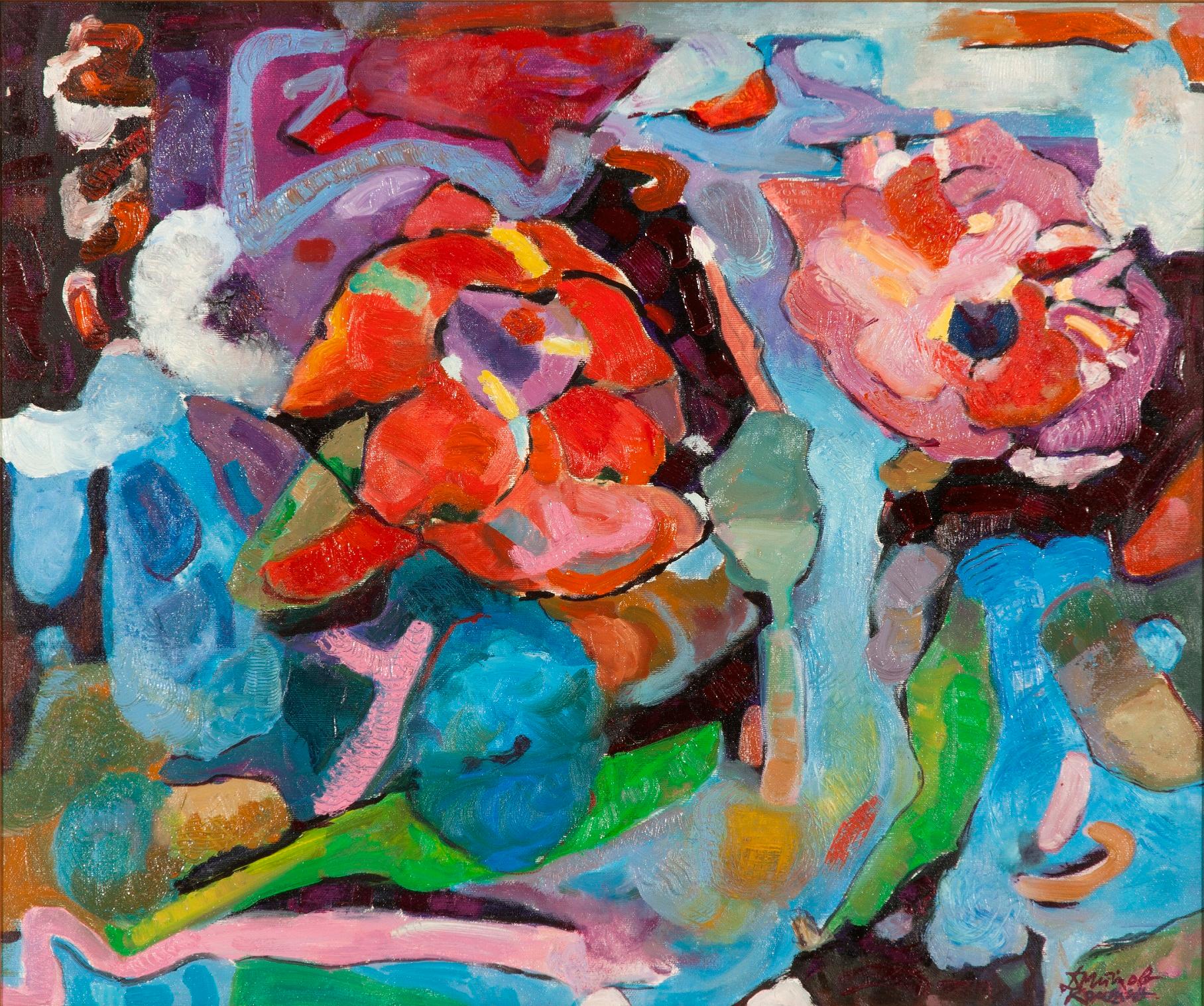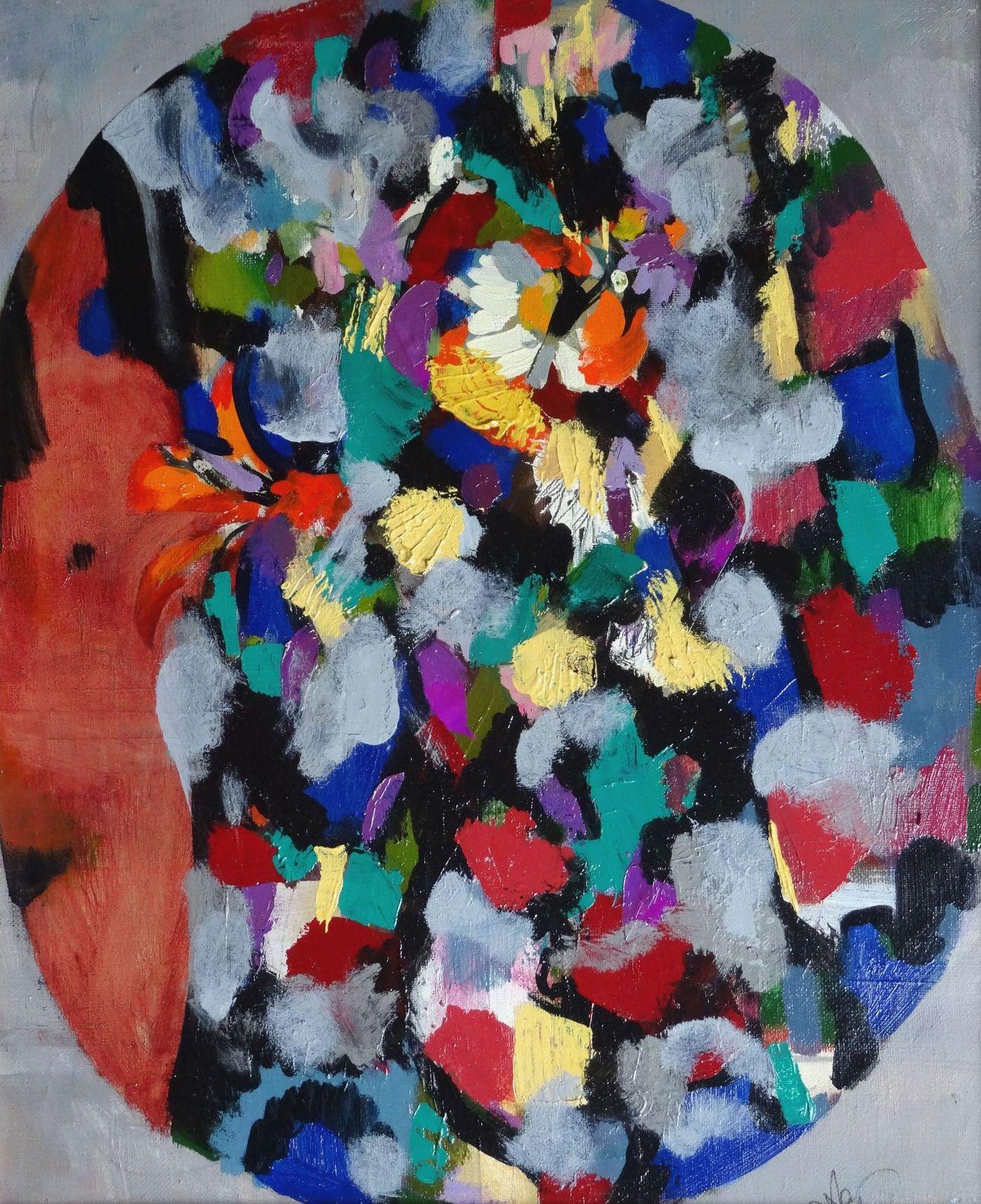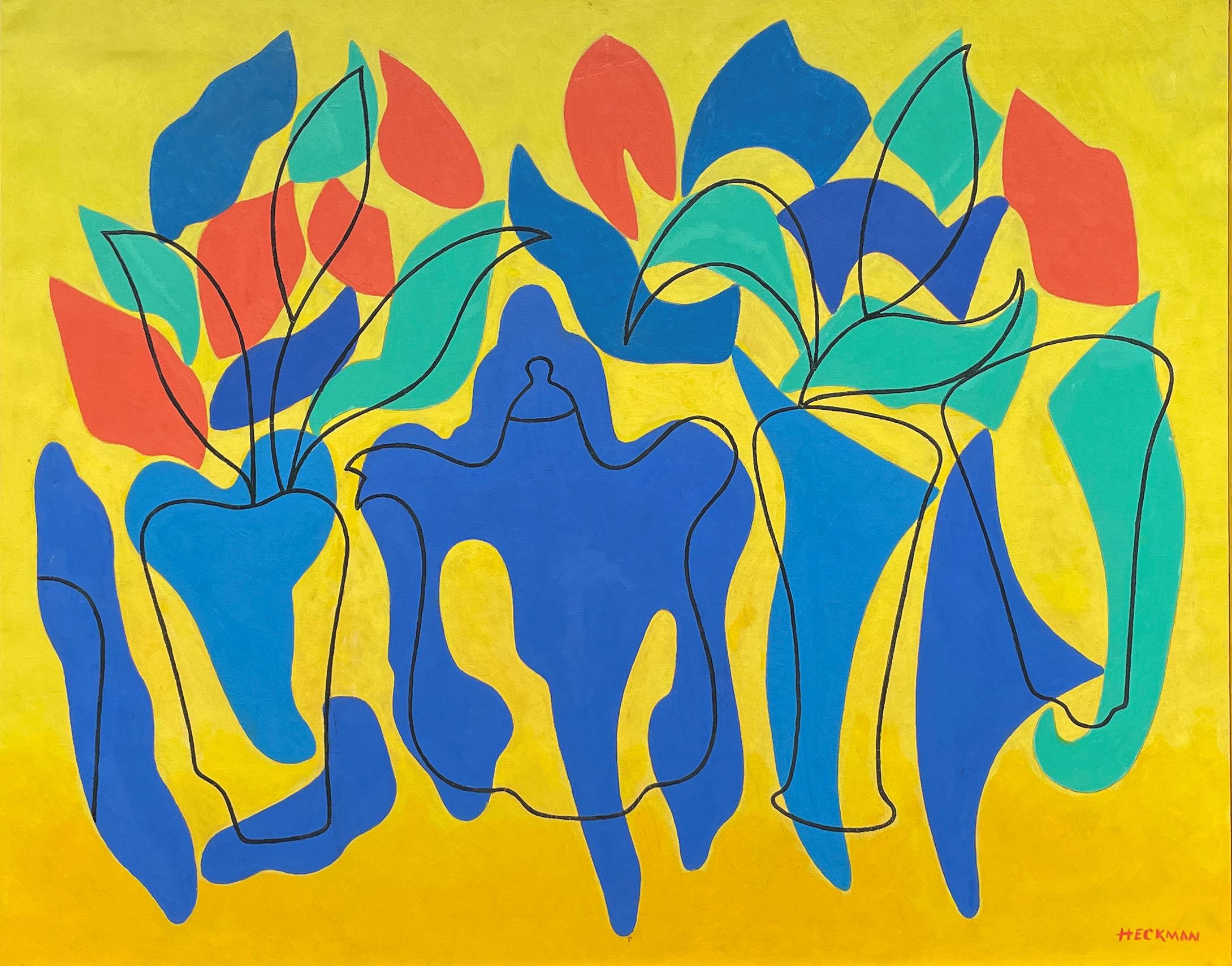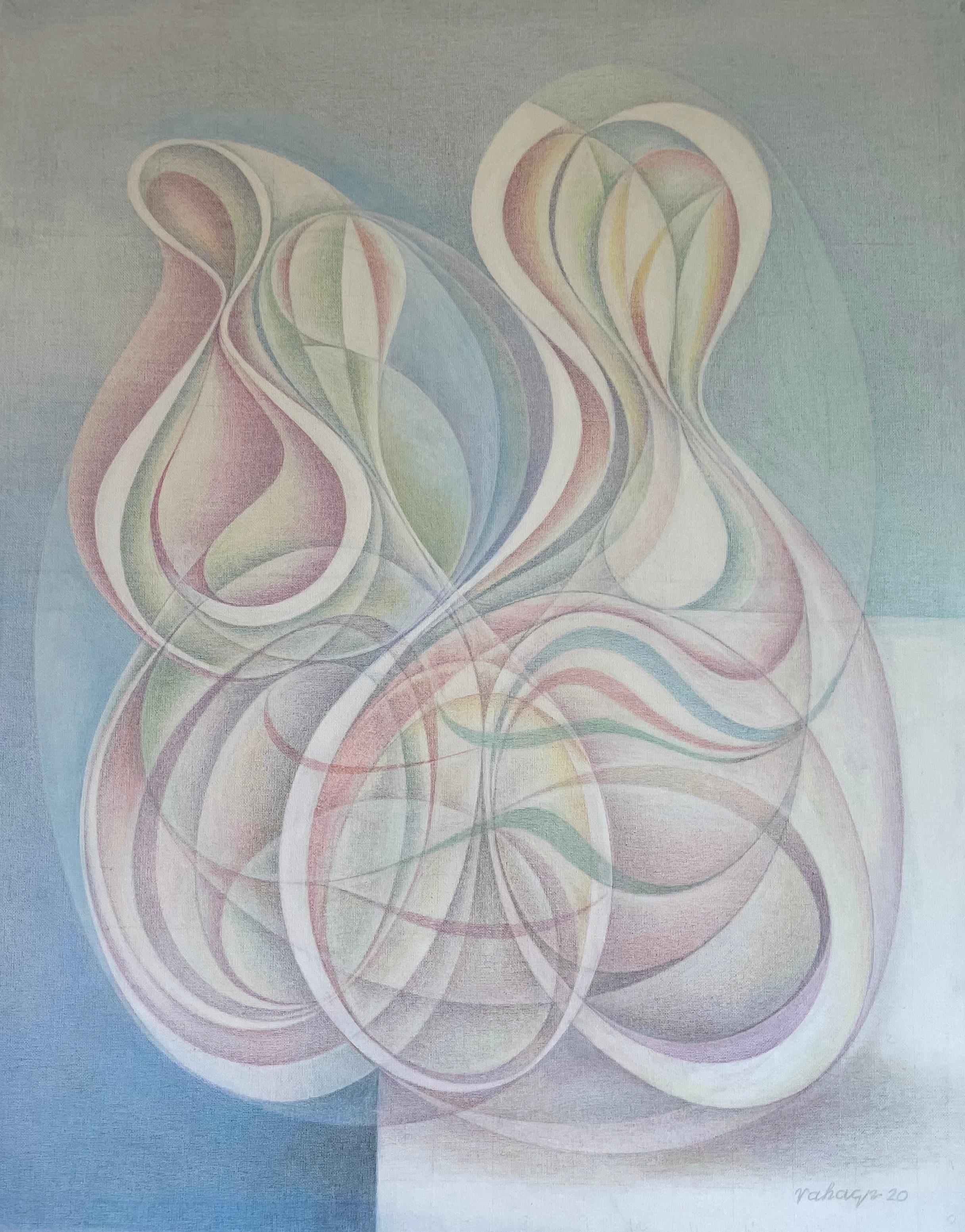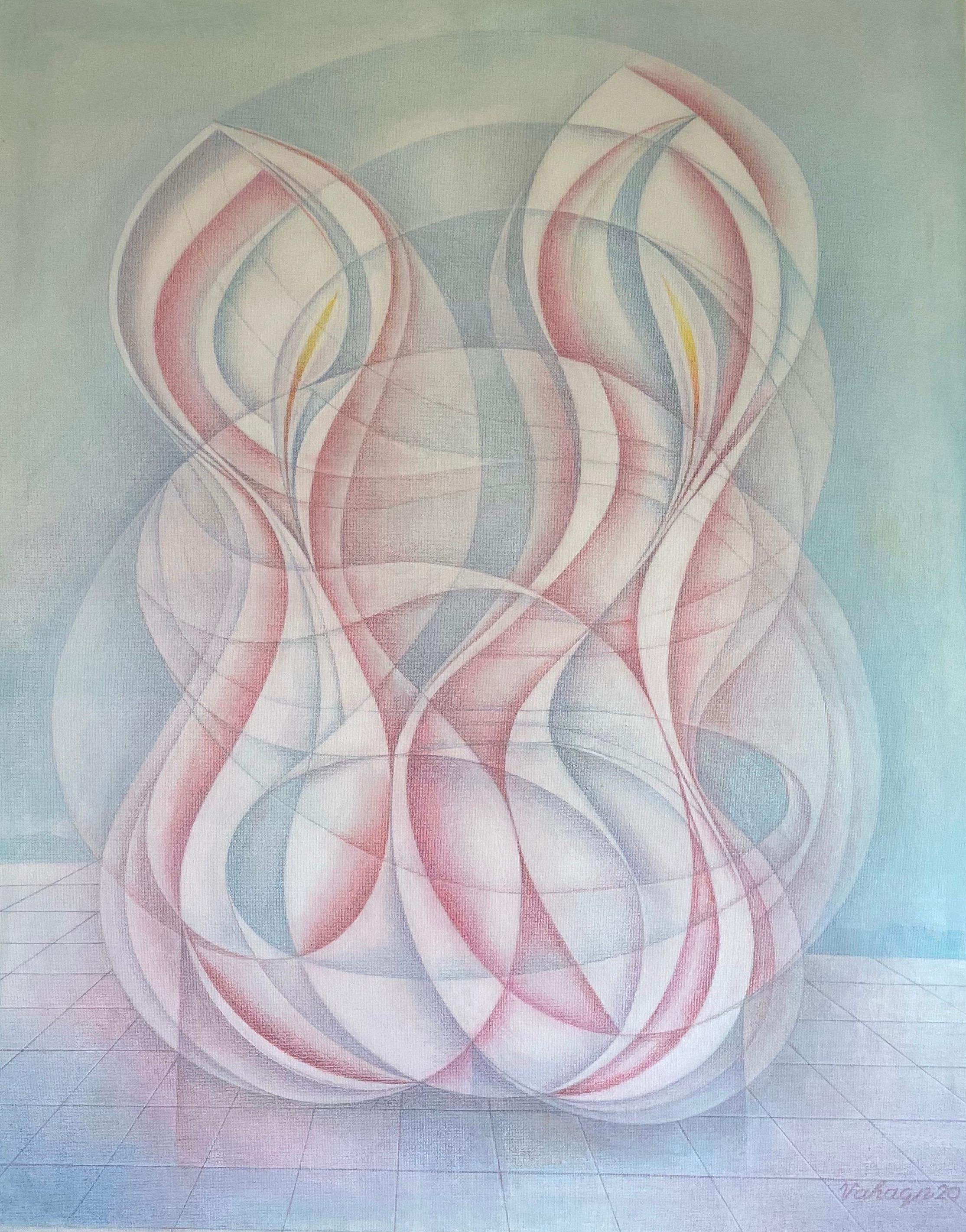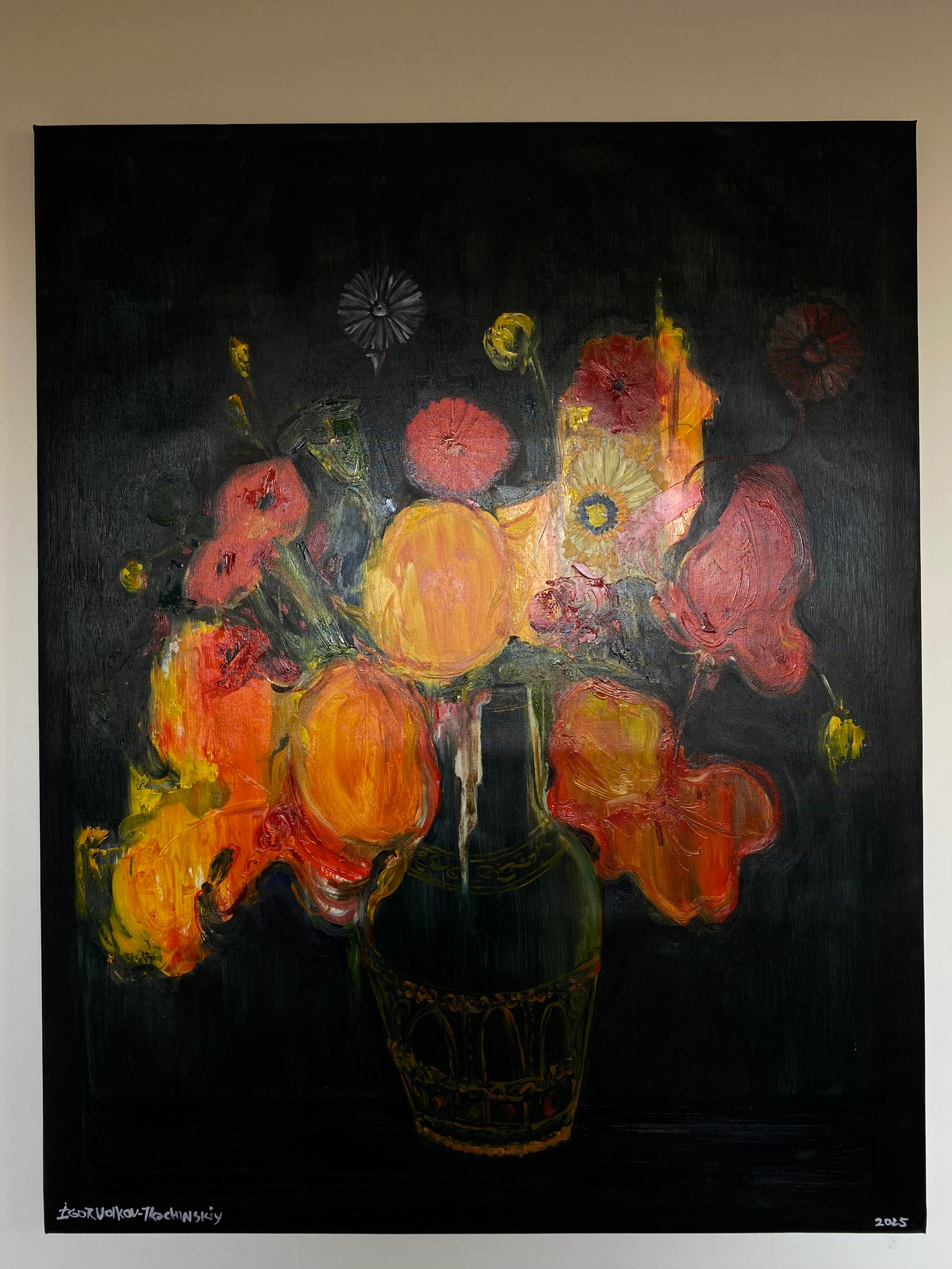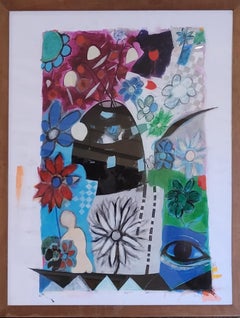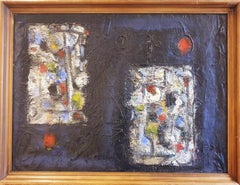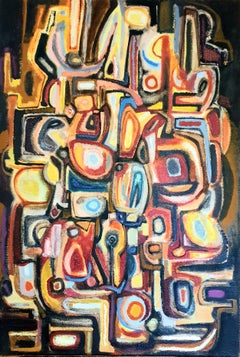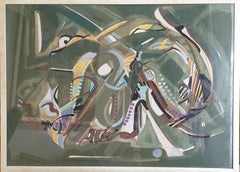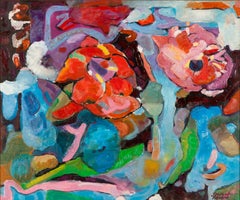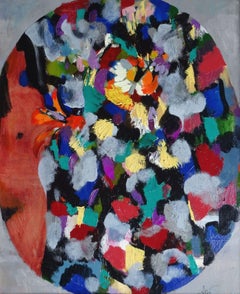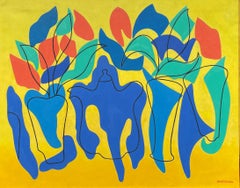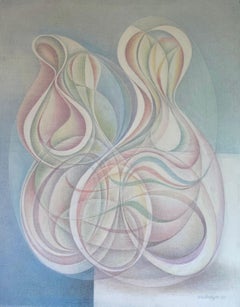Items Similar to Late 20th Century Abstract Oil on Canvas " Flowers ".
Video Loading
Want more images or videos?
Request additional images or videos from the seller
1 of 24
Yuri Vassilievich TitovLate 20th Century Abstract Oil on Canvas " Flowers ".1975
1975
$1,630.30
$2,037.8820% Off
£1,211.09
£1,513.8620% Off
€1,360
€1,70020% Off
CA$2,263.86
CA$2,829.8220% Off
A$2,470.40
A$3,08820% Off
CHF 1,295.76
CHF 1,619.7120% Off
MX$30,003.79
MX$37,504.7320% Off
NOK 16,184.81
NOK 20,231.0120% Off
SEK 15,295.45
SEK 19,119.3220% Off
DKK 10,353.54
DKK 12,941.9220% Off
About the Item
Late 20th century abstract oil on canvas of flowers by Russian artist Yuri Vassilievich Titov. Signed, titled and dated 1975 to the reverse and presented in a black wooden tray frame.
An energetic and highly colourful abstract representation of various flowers. The artist has chosen primary colours for maximum impact and contrast along with strong lines which curve and snake their way across the canvas. The background colours are more muted tones allowing the flower forms to take centre stage.
This painting is joyful and packs a punch.
Yuri Vassilievich Titov was born on January 19, 1928, in the town of Strunino, Vladimir region, between Alexandrovo and Zagorsk, not far from the famous Trinity-St. Sergius Monastery, one hundred kilometers from Moscow. Soon after his birth, his parents - the father an engineer, the mother a teacher of chemistry - moved to the capital, where Yuri began to study in public school No.45.
During the Great Patriotic War, the Titov family was evacuated to the villages of Voskresenskaya and Strunino, where Yuri continued his studies from 1941 to 1943. After their return to Moscow, he finished public school No.589 and then spent a year of preparatory studies in the Steel Institute.
In 1945, Yuri enrolled in the prestigious MAI (Moscow Architectural Institute), from which he graduated six and a half years later with a diploma as an architect. For the next thirteen years, Titov worked in a design bureau. In 1950, he met Elena Stroeva; they were married, and in 1951 their daughter, Lena Titova, was born.
Yuri Titov became well known in Moscow as an abstract painter and later as an iconographer. It is enough to look at reproductions of his painting of the sixties and seventies to understand why this style earned him the reputation of a dissident. His paintings were known througthout Moscow, got as far as the USA, and he had a one-man exhibition in Sweden. The Titov family became famous in the emerging circles of the dissidents and fighters for human rights. Yuri and his wife, Elena Stroeva-Titova, a journalist with a diploma from Moscow State Uiversity, received in their home Esenin-Volpin, Maximov, Nekrasov, Solzhenitsyn, Yakir, Father Yakunin, and visitors from abroad.
As dissidents the Titovs were often placed in psychiatric clinics, particularly the Kaschenk clinic of sad repute. At the beginning of the seventies, they were once again summoned to the KGB and were given to understand that it would be better for them to leave the country. Otherwise their freedom could not be guaranteed.
In 1972, Yuri Vassilievich decided to make use of an invitation for himself and his wife to emigrate to Israel, and he offered to take his daughter with them. While being transported, some of Titov's paintings had acid poured on them at customs in the Sheremetov airport. Some of the paintings never reached the west or else fell apart. After a brief stop in Rome, the Titovs came to settle permanently in Paris and lived near the cathedral of Notre Dame. Their daughter was sent to study French in the St. Georges boarding school near Paris. Yuri was given a studio by the city, which he had use of until 1994.
The difficult conditions of emigration, the problems of adjusting to France, the absence of recognition, and disappointment with western society were too much for Elena Titova to bear. In 1975, while Yuri was asleep, his wife committed suicide by hanging herself in the apartment they rented in the fourteenth arrondissement, on the rue Raymond-Losserand. Yuri Vassilievich wound up in a psychiatric hospital in the Parisian suburb of St.-Geneviève-des-bois.
For some time Yuri Vassilievich Titov withdrew to an Orthodox monastery ninety kilometers from Paris. In 1988 he was accepted as a tenant in the famous Château du Moulin de Senlis in Montgeron, a refuge for Soviet émigrés. In 1997 Titov left Montgeron and again became a frequent inmate of psychiatric clinics. The police refused to extend his residence permit; his other documents were stolen from him. Suffering from insomnia, starving, Titov wandered about Paris, sometimes sleeping in the street or in squats. In that situation, he was again picked up by the pychiatric services.
In 1999 the artist Alexei Khvostenko (1940-2004) and the composer Kamil Tchalaev rescued Titov from the White House, a specialized hospital in Neuilly-sur-Marne, where he was in the custody of a private individual who was having him "treated" by mind-altering drugs. They succeeded in placing him in a house for the dependent elderly called "Zemgor," in Cormeilles-en-Parisis, run by the Russian Red Cross, which in turn took Titov into its custody.
Titov's initial period in this "peaceful institution" did not pass without trouble. He went on with his creative work, fashioning, in particular, a number of packages which he hung mainly in his own room. These "packaged happenings" prevented the personnel of the establishment from cleaning his room; the situation was aggravated by Yuri Vassilievich's taking some linen napkins from the dining room, which he used for his installations. The personnel could not understand what Titov was up to, mutual tension resulted, and he was accused of stealing five hundred napkins and disturbing the peace. The incident coincided with a change in administration of the Zemgor house for the elderly. Titov was sent to a psychiatric clinic for three weeks. In the end, he returned to his room in the "Pink House" of the Dolgopoloff pavilion and was allotted additional space on the edge of the grounds, which from then on served him as a studio.
Throughout his life, Titov remained in a state of constant inner work. In later years he remained creatively active. Over a period of two years, he sketched about two hundred sheets of large format, and filled hundreds of sheets with his "architectural mystical projects" and metapoetry. All this was accompanied by written communications with the two Elenas, wife and daughter – Elena Yurievna.
Titov considered his work a search for harmony between philosophy and mysticism. He began this search with abstract art, went through iconography and religious themes. For him everything is "tied in one knot." He understands "the meaning of the creative act" in the same way as Nikolai Berdyaev (1874-1948, a philosopher exiled from Russia in 1922, who spent the rest of his life in France), the most important Russian philosopher in Titov's opinion, who wrote a book of that title in 1915. Yuri Vassilievich considers himself an architect, the creator of mystical projects, "mystically real, which could be carried out." "There is everything in life," says Titov, "including nothing."
- Creator:Yuri Vassilievich Titov
- Creation Year:1975
- Dimensions:Height: 25.4 in (64.5 cm)Width: 21.86 in (55.5 cm)Depth: 1.38 in (3.5 cm)
- Medium:
- Movement & Style:
- Period:
- Condition:A flaked area to the top left of the painting.
- Gallery Location:Cotignac, FR
- Reference Number:Seller: GB/Titov/Flowers.1stDibs: LU1430214628372
About the Seller
5.0
Platinum Seller
Premium sellers with a 4.7+ rating and 24-hour response times
Established in 2000
1stDibs seller since 2020
263 sales on 1stDibs
Typical response time: 2 hours
- ShippingRetrieving quote...Shipping from: Cotignac, France
- Return Policy
Authenticity Guarantee
In the unlikely event there’s an issue with an item’s authenticity, contact us within 1 year for a full refund. DetailsMoney-Back Guarantee
If your item is not as described, is damaged in transit, or does not arrive, contact us within 7 days for a full refund. Details24-Hour Cancellation
You have a 24-hour grace period in which to reconsider your purchase, with no questions asked.Vetted Professional Sellers
Our world-class sellers must adhere to strict standards for service and quality, maintaining the integrity of our listings.Price-Match Guarantee
If you find that a seller listed the same item for a lower price elsewhere, we’ll match it.Trusted Global Delivery
Our best-in-class carrier network provides specialized shipping options worldwide, including custom delivery.More From This Seller
View AllContemporary Colorful Abstract Acrylic and Pastel. Still-Life of Flowers.
Located in Cotignac, FR
A contemporary abstract still-life of flowers in a vase by French artist Gérard Israel. Presented in a wooden frame under glass.
This vibrant artwork masterfully combines mixed medi...
Category
21st Century and Contemporary Abstract Paintings
Materials
Oil Pastel, Acrylic
'Monogrammes'. French Mid-Century Abstract Expressionist. Oil on Canvas.
Located in Cotignac, FR
A mid-century abstract expressionist oil on canvas presented in a plain wooden frame. The work is titled and there are initials 'G.O.' (artist?) on a label to the rear stretcher as w...
Category
Mid-20th Century Contemporary Abstract Paintings
Materials
Canvas, Oil
$2,493 Sale Price
20% Off
Mid-Century French Abstract Expressionist Oil on Canvas.
Located in Cotignac, FR
A large mid-century French abstract expressionist oil and acrylic on canvas by Jean-Louis Ladislas. Signed and dated 69 to the reverse. Presented in a slim baton wood frame.
A highl...
Category
1960s Abstract Expressionist Abstract Paintings
Materials
Canvas, Oil, Acrylic
Late 20th Century Abstract Expressionist Gouache on Paper.
Located in Cotignac, FR
Lyrical abstract expressionist gouache on paper by French artist Michel Loiseau. Signed bottom right.
Michel Loiseau-Rizzo, born in 1937 is an illust...
Category
Late 20th Century Abstract Expressionist Abstract Paintings
Materials
Paper, Gouache
$885 Sale Price
54% Off
French Abstract Expressionist Oil on Canvas, Les Alliance au Crepuscule
Located in Cotignac, FR
French late 20th Century Abstract Expressionist oil on canvas by Abstrus. The painting is signed bottom right and signed titled and dated to the rear stretcher. Presented in a fine b...
Category
Late 20th Century Abstract Expressionist Abstract Paintings
Materials
Canvas, Oil
Mid-century Abstract Expressionist Oil on Canvas.
Located in Cotignac, FR
Mid-century abstract expressionist oil on canvas by French artist, André Tardieu, signed and dated 1976 bottom right. Also with signature, ...
Category
Mid-20th Century Abstract Expressionist Abstract Paintings
Materials
Canvas, Oil
You May Also Like
Flowers - Abstract Oil Painting Blue Green Brown White Red Orange Yellow
By Dimitar Mitov - Komshin
Located in Sofia, BG
"Flowers" is a modern, abstract oil painting by Maestro Dimitar Mitov-Komshin
About the artwork:
TECHNIQUE: oil painting
STYLE: Abstract, Contemporary
Edition : Unique, signed
Wei...
Category
2010s Abstract Abstract Paintings
Materials
Canvas, Oil
Flowers. 1996, oil on canvas, 69x57 cm
By Janis Zemitis
Located in Riga, LV
Flowers. 1996, oil on canvas, 69x57 cm
In 1958 he graduated from the Riga Art School of J. Rosenthal, in 1964 Art Academy of Latvian State, painting department, Head of the diploma work "Working in the forest" E. Kalninsh.
He participated in the exhibition since 1966.
Member of Artists Union of Latvia since 1970. From 1993-2000 member of the Association "B13".
He worked as a teacher at the Riga 19th school and in the 17th evening high school (1961-1965), in the Riga Art School of J. Rosenthal (1965-1981), worked at the Arts Academy of Latvia since 1981 - in charge of Department of Painting (1993- 1998), professor since 1993. From 1997- 2000 Professor at the Evangelical Lutheran Christian Academy of Latvia.
At the end of the 60s, in the 70s painted many figurative compositions of the historical genre. Reborn impression of cubism, painted still lifes and landscapes.
Paintings by Janis...
Category
1990s Abstract Abstract Paintings
Materials
Oil, Canvas
$1,745 Sale Price
20% Off
"Untitled" Albert Heckman, Still Life, Floral Abstracted Modernist Composition
By Albert Heckman
Located in New York, NY
Albert Heckman
Untitled, circa 1950
Signed lower right
Oil on canvas
25 1/4 x 32 1/4 inches
Albert Heckman was born in Meadville, Western Pennsylvania, 1893. He went to New York City to try his hand at the art world in 1915 after graduating from high school and landing a job at the Meadville Post Office. In 1917, at the age of 24, Heckman enrolled part-time in Teachers' College, Columbia University's Fine Arts Department to begin his formal art education. He worked as a freelance ceramic and textile designer and occasionally as a lecturer at the Metropolitan Museum of Art. In the early 1920s, at the age of almost 30, he graduated with a Bachelor of Arts degree from Columbia Teachers College. He was especially impacted by his instructor at Columbia, Arthur Wesley Dow.
After graduating, he was hired by the Teachers' College as a Fine Arts instructor. He stayed with Columbia Teachers' College until 1929, when he left to attend the Leipzig Institute of Graphic Arts in Leipzig, Germany. Isami Doi (1903-1965), who was born in Hawaii, was arguably his most impressive student at Columbia. Doi is now regarded as one of the most prominent artists hailing from Hawaii. Heckman became an active member and officer of the Keramic Society and Design Guild of New York in the 1920s as part of his early commercial art career. The Society's mission was to share knowledge and showcase textile and ceramic design exhibits.
In 1922, Heckman married Florence Hardman, a concert violinist. Mrs. Heckman's concert schedule during the 1920s kept Albert and Florence Heckman apart for a significant portion of the time, but they spent what little time they had together designing and building their Woodstock, New York, summer house and grounds. A small house and an acre of surrounding land on Overlook Mountain, just behind the village of Woodstock, were purchased by Albert and Florence Heckman at the time of their marriage. Their Woodstock home, with its connections, friendships, and memories, became a central part of their lives over the years, even though they had an apartment in New York City.
Heckman's main artistic focus shifted to the house on Overlook Mountain and the nearby towns and villages, Kingston, Eddyville, and Glasco. After returning from the Leipzig Institute of Graphic Arts in 1930, Mr. Heckman joined Hunter College as an assistant professor of art. He worked there for almost thirty years, retiring in 1956. Throughout his tenure at Hunter, Mr. Heckman and his spouse spent the summers at their Woodstock residence and the winters in New York City. They were regular and well-known guests at the opera and art galleries in New York. Following his retirement in 1956, the Heckmans settled in Woodstock permanently, with occasional trips to Florida or Europe during the fall and winter. Mr. Heckman's close friends and artistic career were always connected to Woodstock or New York City. He joined the Woodstock art group early on and was greatly influenced by artists like Paul and Caroline Rohland, Emil Ganso, Yasuo Kuniyoshi, Andre Ruellan, and her husband, Jack Taylor.
Heckman operated a summer art school in Woodstock for several years in the 1930s with support from Columbia University, where these and other Woodstock artists gave guest lectures. The Potter's Shop in New York City hosted Mr. Heckman's first art show in December 1928. The exhibit received some positive reviews from critics. The American Institute of Graphic Arts chose the plate of "Wehlen, Saxony" as one of the "Fifty Prints of the Year in 1929." There were sixteen etchings displayed. The remaining plates depicted scenes in Saxony, Germany, while five of the plates were based on scenes in Rondout, New York.
Heckman started switching from etching to black and white lithography by the early 1930s. A lifelong admirer of Heckman's artwork, Mr. Gustave von Groschwitz organized a significant exhibition of Heckman etchings and lithographs at the Ferargil Gallery in New York City in 1933. The exhibition traveled to the Stendahl Galleries in Los Angeles (May 1933), the Charles Lessler Gallery in Philadelphia (May 1933), J.L. Hudson in Detroit (June 1933), and Gumps in San Francisco (July 1933). Together with his early etchings, the exhibition featured brand-new black and white lithographs depicting scenes in and around Woodstock as well as "A View from Tudor City...
Category
1950s Abstract Figurative Paintings
Materials
Canvas, Oil
Composition, Abstract Art, Original Painting, Ready to Hang
Located in Granada Hills, CA
Artist: Vahagn Ghaltaghchyan
Work: Original oil painting, handmade artwork, one of a kind
Medium: Acrylic on Canvas
Style: Abstract Art
Year: 202...
Category
2010s Impressionist Abstract Paintings
Materials
Canvas, Acrylic, Color Pencil
$1,600 Sale Price
20% Off
Free Shipping
Composition, Abstract Art, Original Painting, Ready to Hang
Located in Granada Hills, CA
Artist: Vahagn Ghaltaghchyan
Work: Original oil painting, handmade artwork, one of a kind
Medium: Acrylic on Canvas
Style: Abstract Art
Year: 2023
Title: Composition
Size: 30" x 24" x 1'' inch, (76x61x2 cm)
Unframed, Stretched on Wooden Bar, Gallery Wrapped, Ready to Hang...
Category
2010s Impressionist Abstract Paintings
Materials
Canvas, Acrylic, Color Pencil
"The Sun Rejoices, Darkness Gives Strength to Bloom"
Located in Edinburgh, GB
“The Sun Rejoices, Darkness Gives Strength to Bloom” is a still life where flowers seem to be in motion, blending into one another. Sunflowers, carnations, and other plants create a ...
Category
21st Century and Contemporary Abstract Abstract Paintings
Materials
Canvas, Oil
More Ways To Browse
Vintage Wooden Trays
Used Linen Napkins
Russian Cross
Notre Dame Street Oil Canvas
Vintage Linen Napkin
Vintage Linen Napkins
Artist Yuri
Bureau Vintage 1950
St Genevieve
Russian Paintings Soviet
San Francisco Abstract Expressionism
Tony Delap
Venetian Blinds
72 X 60 Painting
Abstract Painting Of Horses
Acrylic Grapes
Bielen Stanley
Bubble Gum Art
